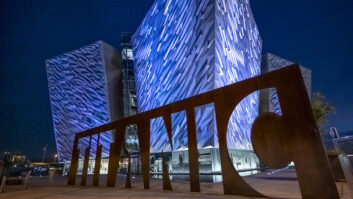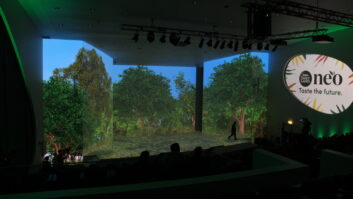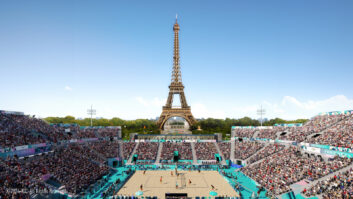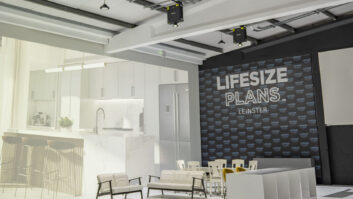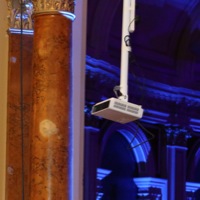
A major change has been taking place in the projector market in recent years, as LED, laser and hybrid projectors have begun to displace their lamp-based equivalents. Ian McMurray seeks enlightenment.
Englishmen of a certain age may remember their fathers referring to someone stupid as being “as dim as the TOC H lamp”. Few of us understood the reference… It turns out, however, that TOC H was a Christian movement founded in the First World War that adopted an oil lamp as a symbol. By definition, the lamp was not very bright.
And speaking of lamps… The venerable lamp has been at the heart of projectors since time immemorial. But, it seems, that’s changing. In fact, it began to change in January 2010, when Casio announced its Green Slim range of hybrid laser/LED projectors, which the company said were the first to achieve 2,000 lumens using solid-state illumination technology.
Thus it was that xenon and mercury lamp technologies found themselves in competition with LEDs, lasers and combinations of the two.
“Today, lamp-based projectors represent at least 95% of total global sales as they use a tried and trusted illumination technology that has been around for at least 50 years,” says Mark Wadsworth, international marketing manager at Digital Projection. “However, as with all technology, people are looking for a better and more cost-effective solution and this is what solid-state illumination sources propose to bring to the market.”
Phil Clark, head of projection at Casio, sees the numbers slightly differently. “With hybrid light source technology accounting for around 10% of units shipped in the UK, it would be fair to say that traditional lamp-based projectors do enjoy the mainstay of the market,” he says.
Major developments
“Projectors using solid-state laser/LED light source technologies have developed significantly in the last few years,” says Tom Gibson, product marketing, visual system solutions at Panasonic. “They’re attractive because they offer a host of advantages when compared with lamp-based projectors. They require less maintenance, with no need to replace lamps and filters. They’re quicker to start up and quicker to turn off. They’re less fragile.”
“There is a constant drive within companies and institutions to reduce cost: the hybrid light source reduces running and maintenance costs offering a fantastic TCO [total cost of ownership] for end-users,” continues Clark. “Not only that, but this new technology removes harmful and toxic substances like mercury from the working environment (due to the absence of lamps), meeting organisations’ drives to improve their green credentials.”
Given such a comprehensive set of advantages, it’s easy to believe that the days of lamp-based projectors are numbered.
Alexis Skatchkoff, product manager, projection at Barco, puts the case for the defence. “Xenon and mercury vapour still have a firm grip on the market, and that’s likely to remain the case for some time,” he says. “I believe the most important reason is their inherent efficiency in terms of lumens per watt, and how they are built and optimised to generate natural white light. New technologies have other strengths and opportunities, but these have not yet gained sufficient importance or traction. As yet, there are no good affordable alternatives for high-brightness projection.”
And, just because there is excitement about the new technologies, it would be a mistake to believe that lamp technology is just lying down and playing dead.
“For the foreseeable future, the vast majority of projectors will be supplied with lamp-based illumination,” believes Wadsworth. “This technology is on a continuous development cycle to reduce costs, increase light output and achieve longer lifetimes.”
An example of that development is cited by Jason Donica, lamp sales specialist, EMEA, at Christie. “The new Superior Performance Xenolite lamps for our Series 1 and Series 2 Solaria projectors last up to 30% longer than existing xenon lamps – we warrant the CDXL-20SP for up to 3,200 hours – and maintain brightness for longer periods than current xenon lamps,” he notes. “Because that means less frequent lamp replacement, users benefit from a lower total cost of ownership.”
“Lamps are still under development,” affirms Skatchkoff. “Continuously offering higher lifetime and higher efficiency is the target. We continue to work with lamp manufacturers to make further improvements.”
Improved architectures
It’s not just about improvements in the lamps themselves, but how projector manufacturers are revitalising lamp-based projector architectures in order to address issues such as resilience and cost of ownership. ‘Eco mode’ – in which the user can swap brightness for lower power consumption and longer lifetime – is now a feature on almost every lamp-based projector. Other changes have taken place too.
“The Panasonic PT-DZ21K 20K lumen projector revolutionised large-format high-brightness lamp-based projection with quad lamp redundancy,” notes Gibson. Along similar lines, Digital Projection offers what it calls ‘sequential mode’ which allows a projector to be run with one, two, three or four lamps, with the projector automatically selecting lamps with the lowest run hours to maximise lamp life. Be that as it may: the new technologies are encroaching.
“The standard is still conventional lamps,” points out Rudi Hradil, chief marketing manager at show control company AV Stumpfl. “But, especially for fixed installations such as museums and visitor centres, the new alternative illumination systems are already the best choice. In multi-display installations, even an ordinary lamp failure is a big disaster. New LED/laser systems are a real advantage because of their reliability, and because there is no need for lamp replacement and the downtime that involves – so ongoing costs for service and maintenance can be reduced dramatically. The system integrator often recommends a more expensive projector solution at the outset, because he knows he will save time and money in future.”
That comparatively recent phenomenon – of looking, not at initial purchase price, but rather at lifetime cost of ownership – is far from unique to the projector industry. It is unquestionably, however, the key driver behind the growing ascendancy of new illumination technologies.
“Traditional lamps in projectors are the single component that have the biggest impact on operations, maintenance and total cost of ownership,” opines Skatchkoff. “Their lifetimes are typically an order of magnitude smaller than the total system. This is something than doesn’t exist in flatpanel displays. Manufacturers, installers and end-users want to get rid of this complexity and cost. The big advantage of the alternative lamp source is the long lifetime and the nearly constant light output over a long period – resulting in lower maintenance time and cost.”
But projector manufacturers are realistic: there is – at least for the foreseeable future – a place for all illumination technologies.
“NEC was the first projector manufacturer to offer a realistic digital cinema 4K laser projector that is available today,” claims Gerd Kaiser, marketing and business development manager for large-venue projectors. “NEC was also one of the first to deliver a mobile projector based on LED technology. In our installation business NEC continues to base our projectors on lamps, because solid-state hasn’t yet been quite good enough to meet our expectations. But that situation is changing, and you’ll see us bring solid-state projectors to the fixed-install market.”
Christie’s position is similar. “Xenon and mercury lamps are key in our fixed-install projector range at the moment and will continue to dominate over the next year or two,” says Donica. “However, over the longer term, laser will begin to dominate, especially when the price of this illumination technology comes down.”
Digital Projection is perhaps a little further down the track. “We’re currently developing prototypes with a variety of illumination technologies,” says Wadsworth. “As with all of our products, ultimately the market will be the driving force on which technologies are used where. Our product line currently offers HID (high-intensity discharge) lamps, xenon lamps and LED illumination technologies, allowing us to provide a projector for every vertical market.”
“Our PT-RW and PT-RZ laser/LED projectors are achieving 3,500 lumens – and our R&D team are looking to push this higher,” says Panasonic’s Gibson. “Higher-brightness laser LED is a big target for manufacturers as many of the benefits of the light source technology are already clear.”
“But it’s important to remember,” he continues, “that choosing a projector isn’t just about the illumination technology. There are many hybrid projectors out there that don’t offer professional features such as edge blending, colour matching and installation-friendly functionality.”
Clark makes an interesting, if contentious, point. “Casio offers a ‘hybrid technology only’ range of projectors,” he points out. “We do not offer lamp-based solutions. It is very difficult for other manufacturers to market this new technology efficiently while still maintaining an existing lamp-based fleet. You cannot highlight the downsides of lamps for example, when your ‘bread and butter’ sales come from lamp-based projectors.”
Mid-ground appeal
As Kaiser and Wadsworth imply: the projector market isn’t ‘one size fits all’. Laser technology is still expensive, but its high brightness and colour fidelity make it especially attractive to cinemas. At the other end of the market, pico projectors will use single LEDs to achieve low cost and high portability. Hybrid LED/laser projectors are likely to prove appealing to the middle ground.
Almost by definition, the ‘middle ground’ represents the largest sector of the projector market. Are the new illumination technologies ready yet for prime time?
“From a technology viewpoint, LED, laser-phosphor and laser are mature,” offers Skatchkoff. “What needs to happen is to make them commercially mature – create market understanding, awareness and acceptance, in order to create volume and bring prices down.”
“In the near future, hybrid will be the dominant solid-state technology,” believes Kaiser, “because the cost of pure laser technology is very high. Later, as costs come down, the amazing colour space and high brightness of laser will see it becoming dominant.”
“The hybrid market is, in ‘human terms’, a teenager,” says Clark. “It has evolved through a number of chassis designs with several tweaks to the light-source configuration. This technology is now ready and primed to move to the next level. With other manufacturers joining the hybrid market, this will help to further stimulate the sector.”
But as Hradil points out, there are still unanswered questions about the new illumination technologies, given that their history has been so short. “What about the reliability of the new LED/laser systems?” he asks. “Are there any ageing problems? For example: can we expect consistency of colour over time? We’ll see.”
“But,” he concludes, “we definitely expect that, in the near future, we’ll see a large number of LED/laser projectors in our fixed installations.”
There can be little doubt that flatscreen technology has eaten significantly into projector sales. While the reasons for this are many – ease of installation, generally better resistance to ambient light and low cost – a key reason has unquestionably been that projectors based on traditional lamp technologies have declined in popularity because of their high cost of ownership. While there are many applications where, for example, brightness is more important – and, as such, lamp-based projection, which is by no means standing still, will continue to dominate large sectors of the market for the foreseeable future – it could be said that projector manufacturers are, finally, seeing the light. n
www.avstumpfl.com
www.barco.com
www.casio-projectors.eu
www.digitalprojection.com
www.christiedigital.co.uk/emea
www.nec-display-solutions.com
www.panasonic.net
pro.sony.com
